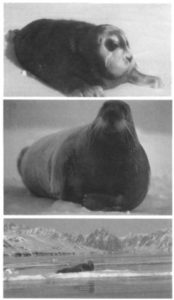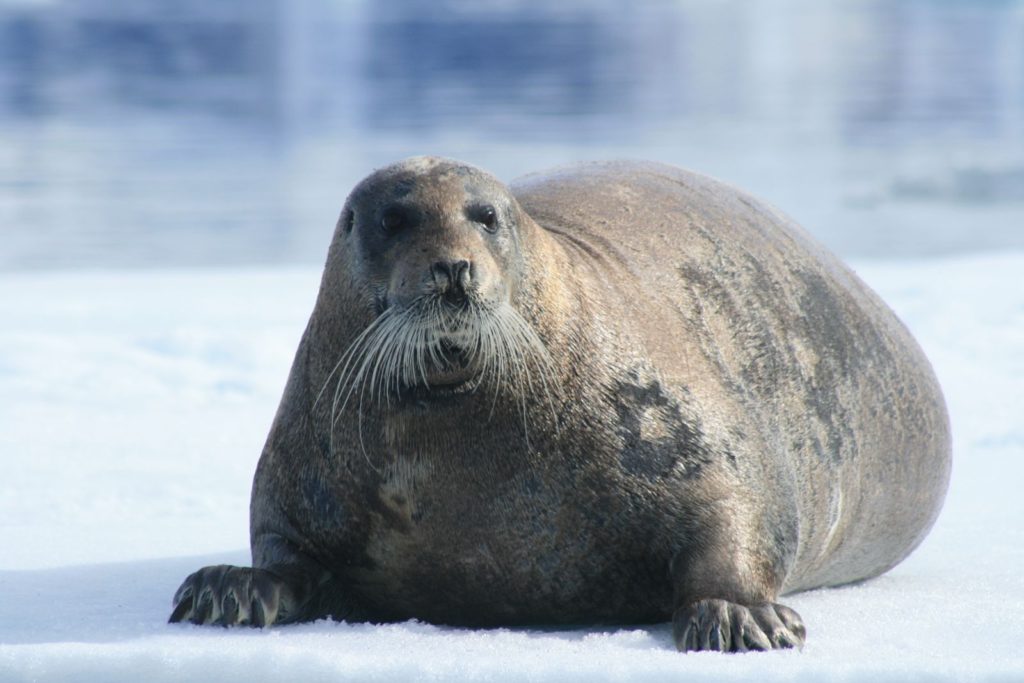We invite you to know about the bearded seals or Erignathus barbatus in scientific terms. These mammals belong to the family of the true seals (earsless) and are the largest of all those that inhabit the Arctic.
Table Of Content
Main Characteristics of the Bearded Seals:
Bearded seals are characterized by their large bodies, which have a fairly rectangular shape and their heads look small compared to the rest of their anatomy. Their frontal fins have square shape and strong claws, with the middle finger being the longest. But their most distinctive aspect lies in their thick whiskers, which tend to curl when dried and are the main responsible for their names.
As for their color, adult individuals present shades of gray and dark and in some cases brown, with the dorsal part of these seals concentrating the darker shades. In some cases there are also spots located on their backs or a series of dots or moles of dark tones on their flanks.
Newborn bearded seals present a grey or brown skin with white spots distributed in their back and part of the head. In addition to the aforementioned, another peculiarity of this species is that they are the only members of the Phochidae family who have two pairs of nipples, similar to the Mediterranean monk seals.
Size and weight
Adult specimens measure between 2 and 2.5 meters long. As for their weight it varies drastically in each annual cycle, but the average is 250-300 kg. However, females of this species are slightly larger than males, and can reach an overweight of 425 kg during the spring. Their bodies´ fat content is approximately 40%, which is very useful for the Arctic cold temperatures.
Alimentation Habits
Bearded seals feed on a wide variety of prey such as clams, shrimp, crabs, squid, fish, and a variety of other small dams found near, on, or on the ocean floor. They can use their whiskers to track prey hidden at the soft bottom of the marine sediment, which they catch by making a combination of expulsion and water suction.
Lets´meet them better
Bearded Seals Habitat and Distribution
Bearded seals are distributed unevenly throughout the Arctic Circle. Their preferred habitats are the ice blocks and icebergs located on shallow water surfaces. During their teenage years they usually roam on fairly large routes, but adults often make small trips near their home, staying in the coastal waters most of the year.
Like the ringed seals , bearded seals are ice-lovers. It is unusual to see them on land; they prefer to crawl out on the ice. However, they occasionally swim to the shores during the summer months. They molt their fur in a more scattered way than other common seals, losing hair during most of the year. What they do have is a concentrated period of molting fur in June and July, during which they prefer not to enter the water.
During this season there is not enough ice in the coastal areas, so bearded seals can be seen in small groups on the existing ice. They don´t swim at great depths, since they feed on the coastal surfaces and therefore don’t require submersion at more than 200 or 300 meters.
However, during their first year the puppies are usually immersed in deeper distances (up to 450 m), but when they are older and more experienced, they remain on the surface, where most of their prey reside.
Recent recounts of bearded seals have not been carried out in their population. The last estimates made in the years 70 and 80 indicated a population of approximately 750.000 individuals.
Let´s learn more about the Earth´s Poles
Bearded Seals Life Cycle and Reproduction?
Bearded seals give birth in spring and their peak period of gestation is at the beginning of May. Normally, the females give birth in small icebergs of floating ice in shallow water. Puppies enter the water quickly, hours after birth, which is probably a response to the mass predation of polar bears. Puppies become competent divers during the 18 to 24 days that are cared for by their mothers. During this time, they consume  about 8 liters of milk daily containing 50% fat. They grow rapidly – on an average scale of 3.3 kg per day and weigh about 100 kg when weaned. Mating occurs at the end of the lactation period, when the male bearded seals usually “sing» to attract females. Their beautiful, but mild and melancholy underwater moans, are made up of a ripple that they perform while they swim downwards and can be heard many kilometers in quiet situations.
about 8 liters of milk daily containing 50% fat. They grow rapidly – on an average scale of 3.3 kg per day and weigh about 100 kg when weaned. Mating occurs at the end of the lactation period, when the male bearded seals usually “sing» to attract females. Their beautiful, but mild and melancholy underwater moans, are made up of a ripple that they perform while they swim downwards and can be heard many kilometers in quiet situations.
Males claim small ocean territories by creating bubble screens, where they sing intensely and repeatedly for several weeks. Some males occupy the same areas for several years. Females reach sexual maturity at five years of age, while males are a little older, when they reach maturity, usually between six and seven years. Bearded seals usually live between 20-25 years.
Do you want to hear?
Bearded Seals Threats and Predators
Polar bears are the main predators of bearded seals, but walruses, killer whales, and boreal or Greenland sharks also feed on bearded seals, particularly puppies. However, we can´t fail to mention the effects of global warming on their habitats. The Arctic Circle has begun to melt because of this phenomenon, altering in a meaningful way the living conditions of all the species that inhabit it.
On the other hand in recent decades some parts of the Arctic seas have become more and more ice free in late summer and early autumn. Since the sea ice is expected to continue to recede because of the climate change, there is an increase in seasonal maritime traffic from tourism and freight.
In fact, in August 2016, the first cruise was sailed by the Northwest Passage (the navigable way of the north that joins the Atlantic and Pacific Oceans). The following year, the first non-icebreaker boat toured the North Sea Route, a road that crosses the Arctic coast of Russia and until recently was impassable by commercial vessels without an escort.
One study has analyzed 80 subpopulations of the seven marine mammals living in the Arctic and identified their risks on or near major sea routes in September, the month when the Arctic has more ice-free water. A total of 42 of these subpopulations would be exposed to boat traffic and the degree of exposure and the particular characteristics of each species will determine which are the most sensitive.



